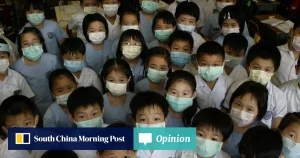The world seems to want to believe that the Covid-19 pandemic is behind us, but in reality new dangers are on the horizon.
The year 2022 closes with a situation in which, in much of the world, life has resumed very much like the 'normalcy' that existed before the Covid-19 pandemic, as almost all countries have shelved the measures taken to contain the Sars-Cov-2 infection. Governments have, in fact, completely ruled out the use of lockdown, reopened schools and public offices, and reduced and phased out the requirement to wear masks. Even international flights and travel have almost returned to pre-pandemic levels.
These days, however, alarm bells are ringing again, the most acute of which comes from China, one of the last countries to relax its anti-Covid control measures, just as the highly contagious Omicron variant was spreading. The scenes in Chinese hospitals, broadcast today on televisions around the world, are reminiscent of the panic that broke out in Hong Kong almost a year ago, when an initial wave of Omicron spread.
 It is possible, and even very likely, that a situation of uncontrolled transmission of the infection would have arisen in China even if President Xi Jinping had not suspended the 'zero-Covid' policy in December, under the pressure of fierce popular protests. The infection, however, has really taken off again and mathematical models predict that there could be more than one million deaths from Covid in China by 2023, combined with a veritable paralysis of the country due to the absence of infected people from work. The economic fallout will be severe in China and around the world, because of the interconnectedness of countries due to globalisation.
It is possible, and even very likely, that a situation of uncontrolled transmission of the infection would have arisen in China even if President Xi Jinping had not suspended the 'zero-Covid' policy in December, under the pressure of fierce popular protests. The infection, however, has really taken off again and mathematical models predict that there could be more than one million deaths from Covid in China by 2023, combined with a veritable paralysis of the country due to the absence of infected people from work. The economic fallout will be severe in China and around the world, because of the interconnectedness of countries due to globalisation.
As far as the Chinese population is concerned, most people are immunologically unprepared for contact with Omicron, the still dominant viral variant, because they have never been exposed to any variant of Sars-CoV-2 and, if they have been vaccinated, they have received active vaccines against the Delta variant. The over-60 population of 128 million people in China - about 1 in 10 out of a total population of almost 1.4 billion - has very low vaccination rates and tends to reject vaccines because of previous government propaganda emphasising the risks.
A further boost to the spread of the infection will come from the opening of borders to tourists: the new wave of Covid from China may then spread to other countries. In addition, the presence of a large population of infected people could open the way for new and more dangerous viral variants.
It is true that, especially for vaccinated individuals, the Omicron variant presents a fairly low degree of danger, with the exclusion of very fragile and/or immunocompromised individuals, who may contract the infection in a severe form, and the long-term effects of the long-Covid syndrome, which has a major impact on the quality of life and work efficiency of those affected.
On the ocular front, an ongoing study in an animal model has found early evidence that Covid-19 may also affect the quality of vision and depth perception of some infected patients. The study is co-conducted by Griffith University's Menzies Health Institute and South Korea's Centre for Research on Emerging Virus Infections, Korea Research Institute of Chemical Technology, and preliminary results have been published in Nature Communications.
For more see: Gi Uk Jeong et al, Ocular tropism of SARS-CoV-2 in animal models with retinal inflammation via neuronal invasion following intranasal inoculation, Nature Communications (2022). DOI: 10.1038/s41467-022-35225-1
Let us conclude by trying to reflect on what would be most appropriate. As far as the individual and private level is concerned, we can suggest maintaining strict hygiene habits - especially with regard to hand washing and food handling - and a certain caution when frequenting crowded places and, first and foremost, airports and healthcare facilities, where the use of a mask is always very useful.
The greatest responsibilities, however, lie with governments, which should keep the surveillance system on pandemic trends active and efficient and, above all, support the network of health structures that may be called upon to manage new emergencies in the future.
We conclude by recalling what must remain a priority: investment in scientific and technological research, because let us never forget that it was investment in research that led us to the vaccines with which we stopped the first deadly Covid pandemic.
On the subject of Covid, you will also find:
Eye Pills - COVID-19 No. 1
Eye Pills - COVID-19 No. 2
Eye Pills - COVID-19 No. 3
Eye Pills - COVID-19 No. 4
Eye Pills - COVID-19 No. 5
Eye Pills - COVID-19 No. 6
Eye Pills - COVID-19 No. 7
Eye Pills - COVID-19 No. 8
Eye Pills - COVID-19 No. 9
Eye Pills - COVID-19 No. 10
Eye Pills - COVID-19 No. 11
Eye Pills - COVID-19 No. 12
